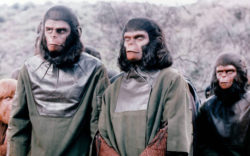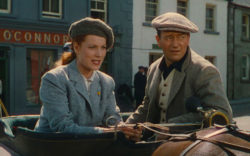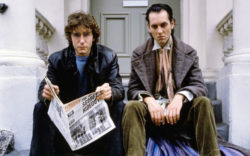If Trump has dragged us into the “post-truth” era, perhaps fiction can provide the best tools for coping with the next four years. The Washington Street Liberation Army, a local grassroots organization founded after the 2008 election but largely inactive of late, returns to present an Inauguration Day screening of the John Carpenter classic They Live, as well as a reunion set from “animation-pop” band The Buddy System.
“After this election, it became clear that people needed something to rally around, as a way to feel like they’re helping their community,” says WSLA founder and The Buddy System member Ryan Lewis. Proceeds from Friday’s concert and screening will benefit the Magnolia Fund, a local abortion-access nonprofit.
Looking to make better sense of the current political climate? Pair They Live with a more recent documentary for a full view of what our country is up against.
Go Out and Watch
Horror auteur Carpenter’s They Live (1988) follows late wrestling legend “Rowdy” Roddy Piper as drifter John Nada, who arrives in Los Angeles seeking work after losing his job in Denver. Nada soon befriends underemployed construction worker Frank Armitage (Keith David). Our hero eventually stumbles upon magic sunglasses that let him see that the businessmen, police and politicians who control society are members of an evil alien race. As declared in the film’s most quoted scene, Nada’s mission following this discovery is simple: “I have come here to chew bubblegum and kick ass, and I’m all out of bubblegum.”
The mysterious alien overlords are an uncanny mirror of Trump and his cronies described as “free enterprisers.” To them, “Earth is just another developing planet: their Third World.” Instead of pursuing the anal probes common to most aliens in film, they are simply capitalists, aiming to drain every bit of profit out of the planet that they can. While the antagonists were originally meant as a criticism of Reagan’s America, it’s easy to see the parallels with an administration so focused on business and oblivious to the big picture that it appoints a climate-change denier to head the Environmental Protection Agency.
Aside from its newfound resonance, They Live remains a testament to Carpenter’s skill at crafting potent visual spectacle on a shoestring budget. Shots from Nada’s point of view filtered through his special sunglasses have an aesthetic that makes potentially boring images fascinating. Color drains from the streets and people of Los Angeles, presenting the viewer with black-and-white images. The laughable cheapness of the makeup and animatronics that give life to the aliens turns to menace when this otherworldly sheen is applied.
Spectacle is also key to the film’s signature scene. After discovering the sunglasses’ eye-opening properties, Nada seeks to share this boon with Armitage, who refuses to put on the glasses. As they argue, the two trade punches, kicks and even bodyslams in staged combat that would have been right at home in Piper’s WWF day job. The fight is memorable for its exhaustive six-minute runtime, but there is an indescribable joy in seeing a Juilliard-trained actor like David take a back suplex like a pro. Carpenter creates amazing visuals with little more than two grizzled actors and an L.A. alley as the raw material.
The title of the film comes from graffiti in a rebel group’s headquarters reading “They Live We Sleep.” While the Trump Administration will likely be the bane of all that is logical, looking to films like They Live for wisdom and guidance helps ensure that we do not remain asleep to that threat.
Stay Home and Watch
Director Penny Lane’s documentary Our Nixon (2013) has a unique relationship with truth that highlights the dangers of normalizing an abnormal president. Our Nixon details the story of the Nixon Administration—from the president’s 1969 inauguration to his resignation in 1974—drawing primarily from over 500 reels of home video that Nixon aides John Ehrlichman, H.R. Haldeman and Dwight Chapin (all of whom went to prison for their parts in the Watergate break-in) captured on Super 8 cameras.
Lane frames the home videos in a way that portrays Nixon as a sitcom hero, starting with the sitcom-style credits, which let us know that the film will be “starring” Richard Nixon. The curved edges common to Super 8 images also lend the appearance of being viewed through a classic television screen. A repetitious, “Welcome Back, Kotter”-esque piano score seeks to compound the portrayal. By painting Nixon as a TV star, Lane shows the normalizing power of television to make hateful ideas and actions palatable to viewers, a tool Trump used to his advantage throughout 14 seasons of “The Apprentice.”
However, Nixon’s secret audio recordings of private conversations and phone calls remind the viewer that the president was indeed a toxic individual. The selected audio showcases Nixon’s homophobia, insecure demands for praise and Machiavellian scheming against his own allies. This technique serves as a relevant warning that just because a hateful ideology receives a familiar gloss, it is not, should not and will never be acceptable.
Like what you just read? Support Flagpole by making a donation today. Every dollar you give helps fund our ongoing mission to provide Athens with quality, independent journalism.










